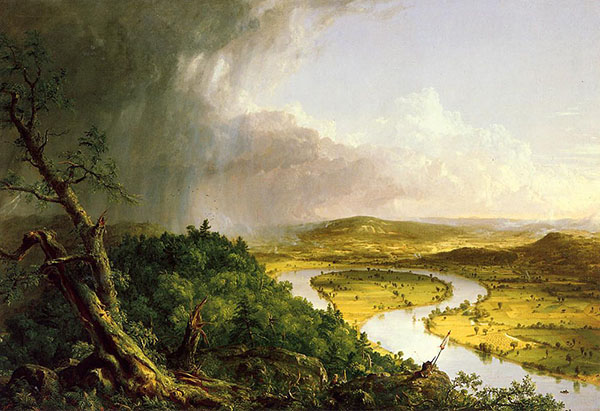
Take a look at the painting above. It’s one of Thomas Cole’s most famous works, commonly known as The Oxbow.¹ It’s got a little something for everyone. A twisted old tree. A menacing thunderstorm. Soaring cumulonimbus clouds. A spot of sunlight. A meandering river. Well manicured farm fields. I could go on and on.
Part of the genius behind Cole’s Oxbow is that it appeals to various cognitive processes that draw us into a landscape. There have been a few frameworks proposed to study how we perceive landscapes, one of which was devised by Rachel and Stephen Kaplan, a husband and wife team in Michigan. The Kaplans’ theory is based on experiments with numerous collaborators where they surveyed the reactions of participants to various landscapes.
After poring over the data, the Kaplans noticed two cognitive processes—understanding and exploration—stood out. Within those processes, they further classified the way we react to different landscapes. Coherence and complexity are different ways we understand a scene, how we make sense of it based information that is physically present. Legibility and mystery are two ways we explore a landscape, how we extrapolate information where detail is lacking. Cole’s painting elicits in us a reaction to each of these, but one more so than the others. And that is precisely why it lures us in.
The Kaplans’ theoretical framework for landscape perception is a four-square of variables, with coherence occupying the upper left corner. Cole checks this first box with ease. As with all great art, The Oxbow displays a subtle orderliness that, while not necessarily obvious, balances the painting—the turbulent air and tortured trees give way to the glassy, defined river and neatly delineated farm fields—while imbuing it with suspense—our eyes sweep downwards from the dark clouds in upper left, following the trunk of the tree and canopies behind it down to the banks of the river, which disappears out the lower right.
From there our eyes are free to roam the details, picking out the umbrella jutting out from a promontory. Or following the slope back to find Cole himself tucked next to a rock, painting that very scene. Or the clearcuts on the hillside in the background. These details enliven the painting with complexity, which happens to be the Kaplans’ second variable, nestled in the upper right of their square. Our brain delights in such complexity, which is complexity with order. The bright river curling through the center of the painting, anchors the scene, giving order to the surrounding commotion. If we are ever overwhelmed with detail, we can always find our way back to the great silver arc. The availability of such landmarks also happens to be another of the Kaplans’ pillars, the somewhat oddly named legibility. Legibility is our ability to navigate a landscape within our brain. We rarely get lost in “legible” landscapes, but can be hopelessly disoriented in busy, messy ones.
That leaves us with one square still undefined. It is what the Kaplans consider to be the most important part of landscape perception, and the reason why I think so many people find The Oxbow so captivating. Mystery. The Kaplans define it as the “promise of new but related information”, and Cole’s painting has it in spades. The gusty thunderstorm provides motion to the scene, promising to upend the tranquility of the valley, or perhaps topple another tree. The dim, hazy horizon hints doesn’t reveal the remainder of the scene, instead leaving the viewer to discover it in his or her imagination. The river, too, hints that more lies beyond the frame.²
The Oxbow is a case of art imitating life more than a century before life caught up with a theoretical cognitive framework for studying landscape perception. Thomas Cole enshrined in oil and canvas a perfect landscape to delight our brains. In a way, it was an easy task to accomplish—after all, it’s an idealized scene. Replicating such complexity, motion, comfort, and mystery in real landscapes is much more difficult. Yet as we continue to modify the natural world apace, that is exactly what we will have to do if we want more than willy-nilly weeds. Just the other day, the National Park Service announced that it would be removing some Ponderosa pines from the floor of Yosemite Valley to restore the grand vistas of El Capitan. Such management also has an ecological benefit, restoring prairies that disappeared when fire was eliminated a century ago. But it is also a harbinger of what seems to be inevitable—the complete human management of the world’s ecosystems.
As we turn the world into our canvas, important choices will have to be made. Which ecosystems do we value at the expense of others? Who decides which ones have value? What tools will we use, and what is our vision? From my brief scan of the mighty stack of research on landscape perception, it’s clear that not everyone will have the same opinions. But there do seem to be hints of universality here and there. It will be a long time before we discover which landscapes, if any, bind us together. But in the meantime, I’ll be sifting through the papers, sharing my thoughts along the way. Stay tuned.
- The actual title is far longer, more Romantic with a capital R, and less catchy: View from Mount Holyoke, Northampton, Massachusetts, after a Thunderstorm. ↩
- It seems to be flowing to the lower right corner, though I have no way of knowing this for certain except that it just feels right. I suspect Cole knew this. ↩
Source:
Kaplan, R., Kaplan, S., & Brown, T. (1989). Environmental Preference: A Comparison of Four Domains of Predictors Environment and Behavior, 21 (5), 509-530 DOI: 10.1177/0013916589215001
Related posts:
Managing landscapes for aesthetics
This is your brain in the city
Scientific American Guest Blog: Why we live in dangerous places